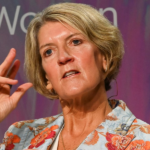New business ideas can come from almost anywhere. Sara Blakely’s bright idea was behind her the whole time—literally.
In 1998, the founder and former CEO of the women’s shapewear brand was working as a fax machine salesperson when she got the inspiration for Spanx. Her white pants had hung in her closet for eight months without wear because she couldn’t get the “smooth look” she wanted. Blakely, then in her mid-20s, wanted to wear something that wouldn’t show panty lines and came without the bulk of the classic girdle—so she cut the feet off control-top pantyhose.
Blakely had never taken a business class in her life, nor had she worked in fashion or retail—and she had only $5,000 to her name to invest in the business. A string of hosiery manufacturers turned Blakely’s initial pitch down.
“They would always ask me the same three questions. They would say and you are? Sara Blakely. And you’re with? Sara Blakely. And you’re financially backed by? Sara Blakely,” she said. “They’d show me the door and say no, thank you.”
What made Blakely’s product take off? Self-assurance.
“I’ve always trusted my gut through the journey,” Blakely said. “I think it’s very important to be authentic.”
While Blakely got a lot of initial nos on her idea that would ultimately transform women’s hosiery as we once knew it, it didn’t stop her from pitching one of the biggest names in fashion: Neiman Marcus. Blakely called her local Neiman Marcus store in Atlanta, where she was living at the time, and they redirected her to the company’s buying office in Dallas.
“I’m Sara Blakely and into the product that’s going to change the way your customers wear clothes,” she told them on the phone. Neiman Marcus’ buying office said they’d give Blakely 10 minutes in person to pitch her idea if she’d fly herself there.
Blakely was about five minutes into her pitch when she realized her idea wasn’t totally resonating with the buying representative, so she made a snap decision to model the product. She guided the buying rep to the bathroom, modeled her white pants with and without Spanx on—and in that moment, her concept was received.
“She immediately [said], ‘Oh I get it. It’s brilliant—and I’m gonna put it in seven stores,” Blakley said during the Fortune interview. “It was unbelievable.”
The manufacturer who had finally agreed to make Spanx didn’t believe Blakely when she called him the news. In fact, he told Blakely he thought she was just going to “give these as Christmas gifts for the next five years,” she said.
Ahead of Spanx’s 2000 launch at Neiman Marcus, Blakely called her friends who lived near the seven stores to get them to buy the product. She even offered to pay them back for purchasing the product.
“Right when I was running out of friends and money, Oprah called,” Blakely said. “She chose it as her favorite product of the year.”
In 2000, Oprah Winfrey added Spanx to her annual product roundup—and became a long-time fan of the brand. In the subsequent two decades, Oprah continued to champion the brand.
When Blakely originally came up with the idea for Spanx, she realized that hosiery products were so uncomfortable because men were the ones who were making them.
“It had never dawned on me as a consumer, but everybody making our shapewear and hosiery were men,” Blakely said in the Fortune interview. “The people making it were not wearing it—and if they were they were not admitting it.”
“So far, I haven’t tried it on,” Buffett said. “I’m afraid I might be too dangerous with this group.”









